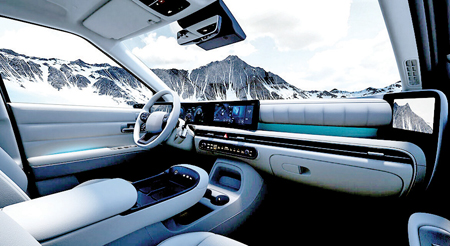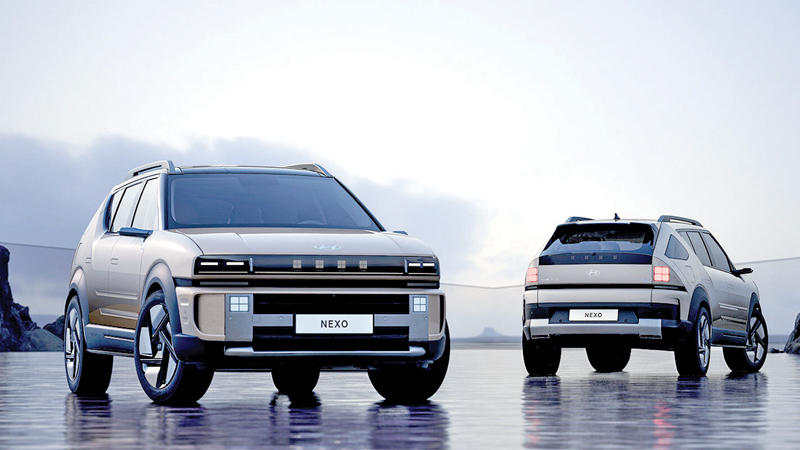Korean carmaker Hyundai has just unveiled the second-generation Nexo at the Seoul Mobility Show 2025 in South Korea. This new hydrogen-powered Fuel Cell Electric Vehicle (FCEV) has undergone a complete makeover with a new design, enhanced features and creature comforts, and a more advanced FCEV powertrain. Hyundai knows what it is talking about here, as it has been making FCEVs for more than 25 years.
Based on the Initium concept unveiled at the LA Auto Show in October 2024, the mid-size SUV follows the brand’s new ‘Art of Steel’ design language with bold lines and a solid structure creating a rugged image, much like the new Santa Fe, which is now available in Sri Lanka. The overall profile is boxy with an arch-shaped cross section giving it a somewhat unique appearance.
The quirky block-pattern lighting elements with the signature “Four Dot” lamps make it instantly recognisable. The front fascia has many square design cues from the upper lighting clusters to the air dam and bumper-mounted block-pattern lamps. The upper clusters are composed of slim lights segmented by a black panel featuring four block-pattern lights.
Six colours
The bonnet has two prominent lines running its length, and the front bumper also integrates D-shaped openings. On the exterior, Hyundai uses a three-coat painting technique, producing a unique, angle-dependent colour shift.
 Hyundai will offer six exterior colour options – White Pearl, Phantom Black Pearl, Gray Metallic, Ocean Indigo Matte, Ecotronic Gray Pearl, and Goyo Copper Pearl. The last colour was inspired by Korea’s nature and culture, embodying the essence of ‘Koreanism’. Named after the Korean word ‘Goyo’, which means ‘serene’ or ‘tranquil’, this colour captures a unique charm that blends Korea’s traditional beauty with a modern aesthetic through its deep and rich tone.
Hyundai will offer six exterior colour options – White Pearl, Phantom Black Pearl, Gray Metallic, Ocean Indigo Matte, Ecotronic Gray Pearl, and Goyo Copper Pearl. The last colour was inspired by Korea’s nature and culture, embodying the essence of ‘Koreanism’. Named after the Korean word ‘Goyo’, which means ‘serene’ or ‘tranquil’, this colour captures a unique charm that blends Korea’s traditional beauty with a modern aesthetic through its deep and rich tone.
Inside, the FCEV Nexo offers a contemporary, minimalist design inspired by the Sante Fe and the Palisade, with a twin-deck centre console that seamlessly integrates with the dashboard. A steering column-mounted gear selector is complemented by a steering wheel that sports a unique quad-dot logo, representing the letter “H” in Morse Code.
The Nexo has twin 12.3-inch displays for the touchscreen infotainment system and digital driver’s instrumentation, wireless Apple CarPlay and Android Auto connectivity, a 14-speaker Bang & Olufsen sound system, ambient lighting, keyless entry with NFC technology, and digital Inside Rear View Mirrors (IRMV) and Outside Rear View Mirrors (ORVM) with cameras to name a few.
However, not all markets will get the camera-fed ORVMs. The infotainment system features wireless Apple CarPlay and Android Auto, plus generative AI for its voice commands. There is also a Head-Up Display (HUD) depending on the trim level.
The Nexo’s electric front seats recline and offer ventilated cushions and fold-out leg rests. Back seat passengers enjoy better headroom and shoulder room and the rear doors open wider too, though not at 90 degrees like some models from other manufacturers.
Nine airbags
There are nine airbags on board and Level 2 Advanced Driver Assistance Systems (ADAS) features like forward collision-avoidance assist, lane keeping assist, blind-spot collision-avoidance assist, blind-spot viewer monitor, emergency stop, navigation based smart cruise control, rear view monitor, surround view monitor, and rear cross-traffic collision-avoidance assist.
Nexo utilises a Smart Regenerative System (SRS) to enhance driving convenience by automatically adjusting regenerative braking based on navigation data and distance to vehicles ahead. Available globally, this system uses extended map information to adapt to road conditions, such as speed cameras, turns, and speed humps. It reduces driver intervention by automatically managing deceleration during coasting, with adjustable vehicle distance settings.
Enhanced fuel efficiency
The powertrain of the second-gen Nexo gets a massive update. The brand new SUV derives power from two sources: a 110kW fuel cell stack and a 150 kW electric motor driving the front wheels. The electric motor cranks out 201 bhp and 350 Nm of peak torque. It derives its energy from a 2.64 kW lithium ion battery.
The all-new Nexo offers increased fuel storage capacity without compromising cabin space. The system’s All-Electric Range (AER) competitiveness is secured through enhanced fuel efficiency, as well as an increased hydrogen tank capacity – which now stands at 6.69 kg, up from 6.33 kg in the previous-generation Nexo – and increased hydrogen storage density.
Hyundai claims the Nexo can travel up to 700 km on a single charge. The Nexo can clock a top speed of 179 Kmph and can accelerate from 0 to 100 kmph in 7.8 seconds. Along with a more powerful fuel stack, which is said to be more durable especially in cold temperatures, the electric motor is more powerful as well.
The all-new Nexo is longer, wider and taller than its predecessor, resulting in improved passenger comfort and increased rear cargo capacity, with a maximum of 993 litres) – enough to accommodate up to four golf bags. Sustainable materials) are used throughout the vehicle, including bio-process leather, bio PU leather, recycled PET fabric, linen fabric, bio plastic, bio TPO skin, bio paint, bio PU slab foam, and recycled automotive plastic waste. The new Nexo will be available in selected markets with hydrogen infrastructure later this year.




